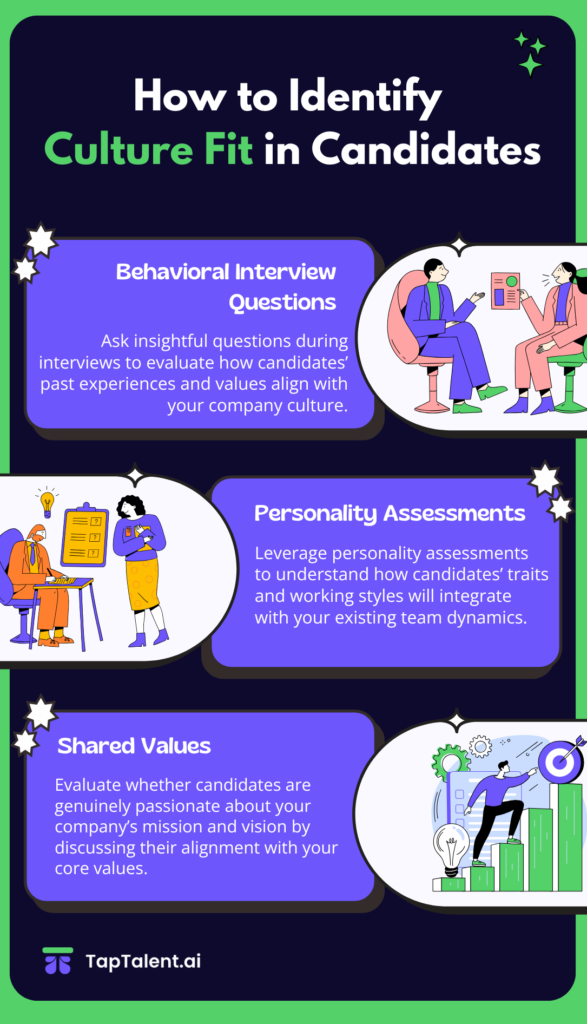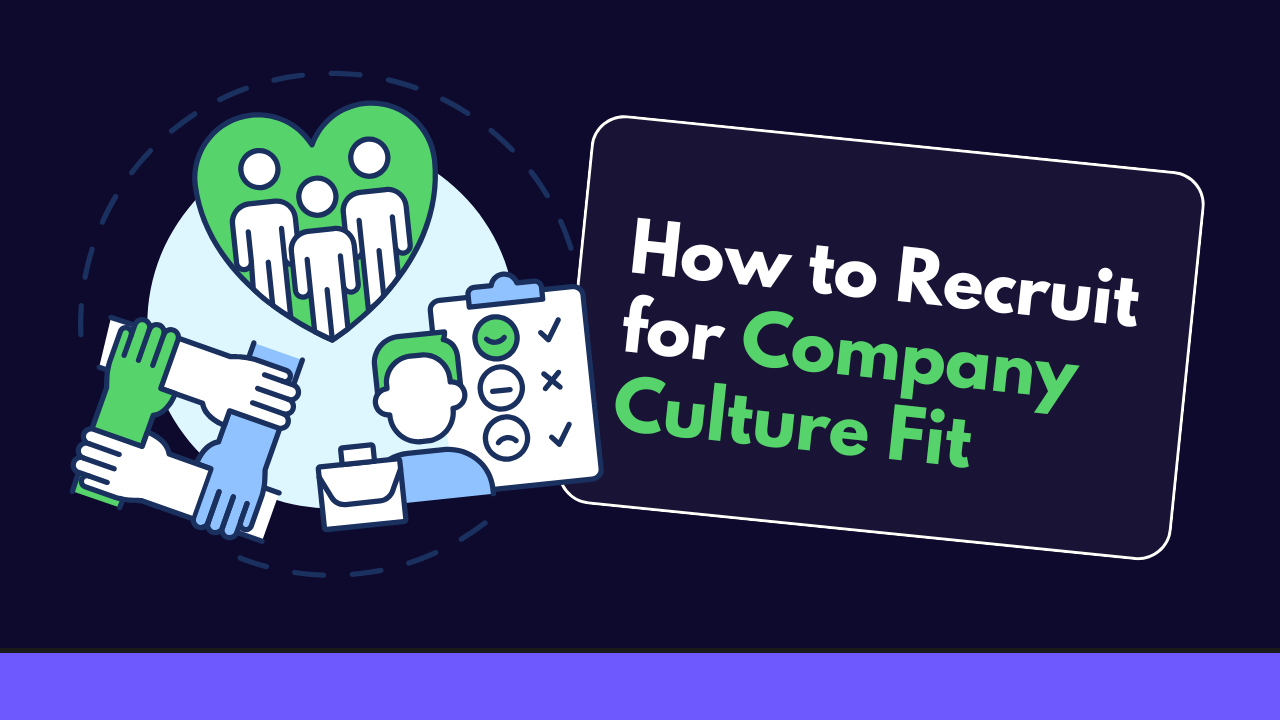Introduction
Skills and experience can get someone in the door, but true success comes when a new hire not only excels in their role but also thrives within your company’s unique culture. In today’s hiring landscape, company culture fit is increasingly seen as a crucial element in building strong, cohesive teams that stay engaged and contribute long-term. So, how do you ensure that your next hire aligns with your culture?
In this blog, we’ll walk you through what it means to recruit for company culture fit, why it matters, and how you can spot candidates who share your company’s values and work style. By understanding this, recruiters can not only enhance retention but also build more satisfied and productive teams.
Let’s start by breaking down exactly what culture fit means and why it’s important to the success of your recruitment strategy.
What Does “Culture Fit” Mean in Recruitment?
Defining Culture Fit
At its core, “culture fit” refers to hiring candidates whose values, attitudes, and behaviors align with the existing norms and values of your company. It’s not just about finding someone who fits in on a personal level—it’s about bringing on employees who naturally support and enhance your company’s mission, vision, and work style.
For example, if your company emphasizes collaboration and open communication, a candidate who thrives in a highly structured, independent work environment might struggle. Conversely, if your company promotes innovation and risk-taking, someone who prefers sticking to traditional methods might not feel comfortable, even if they have all the necessary skills.
Why Culture Fit Matters
Culture fit goes beyond just team chemistry. When an employee shares your company’s values and work style, they are more likely to be engaged, motivated, and loyal. According to studies, employees who align with the company culture tend to be happier in their roles, leading to increased productivity and lower turnover rates. This is critical because high employee retention not only saves on recruitment costs but also contributes to a more stable and cohesive work environment.
In addition, hiring for culture fit helps foster a positive work atmosphere where employees feel a sense of belonging. This encourages collaboration, creativity, and communication, all of which are key drivers of business success.
Key Characteristics of Culture Fit
When assessing culture fit, there are a few key elements to consider:
-
- Shared Values: Does the candidate believe in the core principles your company stands for, such as sustainability, diversity, or innovation?
-
- Work Style: Is the candidate’s preferred way of working compatible with your team’s workflow, whether it’s collaborative, independent, fast-paced, or methodical?
-
- Mission Alignment: Does the candidate show passion for your company’s mission and long-term goals? For instance, in a mission-driven organization, a candidate who is personally motivated by that cause is likely to thrive.
- Mission Alignment: Does the candidate show passion for your company’s mission and long-term goals? For instance, in a mission-driven organization, a candidate who is personally motivated by that cause is likely to thrive.
Finding Balance
While culture fit is important, it’s equally essential not to let it overshadow other critical factors like skills and experience. A well-rounded recruitment process considers both technical qualifications and how well a candidate will integrate into the company’s culture.
In the next section, we’ll discuss the risks of over-emphasizing culture fit, and how to avoid potential biases while ensuring you find the right balance between fit and qualifications.
The Risks of Over-Emphasizing Culture Fit
While recruiting for culture fit has undeniable advantages, it’s important to be mindful of the potential risks. Overemphasizing culture fit can sometimes lead to unintended consequences, such as lack of diversity or an overly homogeneous work environment. As a recruiter, you need to strike the right balance between finding candidates who align with your company’s culture and those who bring fresh perspectives and skill sets to the table.
Potential for Bias
One of the biggest concerns when focusing too much on culture fit is the risk of introducing bias into the hiring process. When culture fit is overvalued, it can sometimes lead to hiring decisions based on similarities rather than competencies. Hiring managers may gravitate toward candidates who remind them of themselves or current employees, leading to a “like hires like” phenomenon. This not only limits diversity but can also reduce innovation and creativity within the team.
For example, if your team has a majority of extroverted employees who thrive in a fast-paced environment, you might unintentionally overlook introverted candidates who prefer a quieter, more deliberate work style, even though they may be equally, if not more, effective. This kind of bias can lead to a workplace that lacks diverse perspectives and experiences, which are crucial for solving complex problems and driving innovation.
To combat this, it’s essential to remain aware of potential biases throughout the hiring process. Use structured interview techniques, focus on specific competencies, and ensure multiple team members are involved in the decision-making process. This can help to minimize personal biases and create a more objective hiring framework.
Balancing Culture with Skills
Another risk is allowing culture fit to overshadow a candidate’s skills and experience. While it’s great to find someone who fits in with your team’s work style, it’s equally important to ensure they have the qualifications to perform their job effectively. After all, the best culture fit won’t make up for gaps in key technical or professional skills.
In fact, some experts argue that skills and qualifications should take priority during the initial stages of recruitment. Once you’ve narrowed down a pool of candidates based on their ability to perform the job, culture fit can then be used as a secondary filter to ensure they will integrate well with the team.
Tips for Finding the Right Balance:
-
- Define Non-Negotiables: Before you start interviewing, define what’s most important for the role—both in terms of skills and cultural alignment. This helps ensure you’re weighing both aspects appropriately.
-
- Evaluate Both Soft and Hard Skills: Don’t let culture fit be the only deciding factor. Ensure candidates meet the technical and professional requirements of the job.
-
- Involve Multiple Perspectives: By getting input from multiple team members, you can balance out individual biases and make a more informed decision.
- Involve Multiple Perspectives: By getting input from multiple team members, you can balance out individual biases and make a more informed decision.
Fostering Diversity and Inclusion
A company with a strong culture often promotes collaboration, teamwork, and shared values. However, this doesn’t mean that every employee should think or behave the same way. Diversity in thought, background, and experience is essential for growth and innovation. Focusing too much on hiring people who “fit” the existing culture can inadvertently create an echo chamber, where everyone has similar perspectives and solutions.
To avoid this, consider shifting from solely focusing on culture fit to hiring for cultural add—candidates who not only align with your values but can also bring new ideas and approaches. This ensures that your company remains dynamic and adaptable, with a team that evolves over time.
How to Identify Culture Fit in Candidates
Identifying culture fit in candidates is crucial for long-term success, as employees who resonate with your company’s values and work style tend to stay longer and perform better. But how can you assess this during the recruitment process without letting bias influence your decisions? By using a combination of targeted questions, personality assessments, and value-based evaluations, you can gain deeper insights into whether a candidate will thrive in your organization.

Behavioral Interview Questions
One of the most effective ways to assess culture fit is through behavioral interview questions. These questions focus on how candidates have handled specific situations in the past, which can provide insight into how they’ll behave in your work environment. Rather than asking hypothetical questions, you’re getting a real sense of their past actions, which often predict future behavior.
Examples of behavioral interview questions:
-
- “Can you give an example of a time when you worked in a team environment with conflicting priorities? How did you handle it?”
-
- “Describe a situation where you had to adapt to a company’s values that were different from your previous workplace. How did you align yourself?”
-
- “How have you contributed to maintaining or improving company culture in your previous roles?”
These questions help reveal whether a candidate’s approach to work, teamwork, and problem-solving aligns with your company’s culture. Look for responses that reflect values important to your organization, whether that’s collaboration, innovation, or accountability.
Personality Assessments
In addition to interview questions, personality assessments are a valuable tool for understanding whether a candidate is a good cultural fit. Tools like the Myers-Briggs Type Indicator (MBTI), DISC profile, or the Big Five Personality Traits test can give you insight into how candidates approach work, communicate with others, and solve problems.
For example, if your company culture values fast-paced decision-making and teamwork, you may want to look for traits such as high extraversion and openness to experience. On the other hand, if your team requires independent work and careful attention to detail, you might prioritize traits like conscientiousness and introversion.
However, it’s important to use personality assessments as one of many data points, rather than a final deciding factor. Personality tests should complement, not replace, more traditional methods of assessing experience and skills.
Assessing Shared Values
Culture fit isn’t just about whether someone’s work style aligns with your team—it’s also about whether they share the same core values. Candidates who are passionate about your company’s mission and vision are more likely to be engaged, motivated, and productive.
To assess shared values, you can:
-
- Discuss company values openly: During interviews, talk about your company’s mission, vision, and core values. Ask candidates to share their thoughts on these values and how they’ve aligned with similar missions in the past.
-
- Pose value-based questions: For example, if one of your values is customer-centricity, you might ask, “Can you describe a time when you went above and beyond for a customer, and why that experience was meaningful to you?”
-
- Use real-world examples: Share examples of how your team lives out its values. Whether it’s through teamwork, innovation, or community involvement, hearing real-life stories can help candidates understand what’s important to your company.
By using value-based questions and having an open discussion about your company’s mission, you can get a clearer sense of whether a candidate truly connects with your organization on a deeper level.
Practical Tip: Combine Multiple Assessment Methods
To ensure a well-rounded evaluation, combine multiple methods during your assessment of culture fit. Relying solely on interviews, for example, may not give you the full picture. Including personality assessments and value-based discussions can help ensure that candidates are not only skilled but also aligned with your company’s cultural expectations.
Cultural Fit vs. Cultural Add
When it comes to recruitment, focusing on cultural fit alone can be limiting. While hiring people who align with your company’s existing culture is important, there’s also immense value in bringing in candidates who can add new perspectives, ideas, and energy. This is where the concept of cultural add comes into play.
What Is Cultural Add?
Cultural add refers to hiring people who don’t just fit in with the existing company culture but who also contribute something new that can improve or diversify the workplace. These are candidates who align with your core values but offer fresh ideas, experiences, or backgrounds that help your organization grow in different directions.
For instance, a company that values innovation might benefit from hiring someone with a background in an industry that operates very differently, as they could introduce new ways of thinking and problem-solving. By focusing on cultural add, you’re creating a more dynamic, well-rounded team that is adaptable and open to growth.
The Benefits of Hiring for Cultural Add
Hiring for cultural add brings several benefits to your company, including:
-
- Increased Diversity: Candidates who add to your culture often bring diverse perspectives and ideas, which is crucial for innovation and problem-solving.
-
- Fresh Insights: New hires who bring different experiences challenge the status quo and push teams to think differently. This can lead to better decision-making and a more creative approach to business challenges.
-
- Improved Adaptability: A team made up of individuals who offer new ideas and perspectives is better equipped to handle change and respond to new market trends or challenges.
By focusing on cultural add, you’re expanding your company’s ability to adapt and evolve, rather than simply maintaining the status quo.
How to Incorporate Cultural Add into Your Hiring Process
Integrating cultural add into your recruitment process involves shifting the way you evaluate candidates. Here are some practical steps:
-
- Rethink Your Interview Questions: Instead of only asking candidates how they fit into your current culture, ask how they would add to it. For example, you could ask:
- “What unique perspective would you bring to our team?”
- “How do you think your previous experiences will help us approach challenges differently?”
- “Can you share an example of how you’ve introduced a new idea or process at a previous company?”
These questions encourage candidates to think about how they can positively influence your company’s culture.
- Rethink Your Interview Questions: Instead of only asking candidates how they fit into your current culture, ask how they would add to it. For example, you could ask:
-
- Evaluate for Core Values, Not Just Similarity: While cultural fit is often about how much a candidate aligns with your current team, cultural add focuses on finding people who share your core values but come from different experiences or have unique viewpoints. For instance, if your company values collaboration, hire someone who embodies that trait but has a different communication style or problem-solving approach.
-
- Look Beyond the Resume: Candidates who add to your culture might not always have the same background as your current employees. Look for transferable skills, fresh perspectives, and unique experiences that can benefit your team, even if their resume doesn’t perfectly match the traditional mold.
- Encourage Diverse Thought: During the hiring process, make it clear that you value diverse perspectives. When candidates know that your company encourages and welcomes new ideas, they’ll feel more comfortable bringing their full selves to the workplace.
Best Practices for Assessing Culture Fit and Culture Add
Finding candidates who align with your company culture while also bringing something fresh to the table can feel like a balancing act. However, with the right strategies in place, you can effectively assess both culture fit and culture add during the recruitment process. Here are some best practices to help you navigate this crucial stage of hiring.
1. Involve Multiple Team Members in the Interview Process
When assessing candidates for cultural fit and add, getting input from multiple people within the company is key. Involving team members from different departments or with varied perspectives can provide a more holistic evaluation of the candidate.
-
- Diverse viewpoints: Each team member may interpret the candidate’s potential fit or contribution to culture differently. For example, while one interviewer might focus on how well the candidate meshes with the team, another might notice how the candidate’s fresh perspective could bring positive change.
-
- Reduced bias: Involving multiple people also helps prevent bias that might arise if a single interviewer overemphasizes cultural fit and overlooks the candidate’s skills or potential to add value.
You can organize panel interviews, or have candidates meet team members in casual settings to see how they interact naturally. This approach gives a fuller picture of how the candidate will fit within the broader company environment.
2. Use Behavioral Interview Questions
Asking the right questions during interviews is essential for assessing culture fit and add. Behavioral questions help you understand how a candidate has handled real-world situations that reflect your company’s values or mission.
Here are a few examples:
-
- For culture fit, ask questions like:
-
- “Tell me about a time when you collaborated on a challenging project. How did you handle conflict within the team?”
-
- “Describe a situation where you had to align your approach with company values in a tough situation. How did you navigate that?”
-
- For culture fit, ask questions like:
-
- For culture add, focus on questions that encourage candidates to demonstrate how they can bring fresh ideas or new perspectives:
-
- “How have your previous experiences shaped your approach to innovation or problem-solving?”
-
- “What’s a new perspective or skill set you’ve brought to a team that helped the team grow or succeed?”
-
- For culture add, focus on questions that encourage candidates to demonstrate how they can bring fresh ideas or new perspectives:
Behavioral questions give you insight into how candidates think and act in scenarios that matter to your business, helping you judge both fit and potential for cultural contribution.
3. Incorporate Personality Assessments
Personality assessments can be a useful tool for evaluating whether a candidate’s traits align with your company’s culture and team dynamic. These assessments offer deeper insights into how a person works, how they communicate, and how they interact with others.
-
- Culture fit: Use personality tests to see if the candidate’s work style matches the existing team. For example, if your team thrives on collaboration, you might look for candidates who score high on traits like teamwork and communication.
-
- Culture add: Personality assessments can also reveal how a candidate might contribute new strengths to the team. If you’re hiring for diversity of thought, look for candidates who score high on traits like creativity or leadership.
However, remember that personality assessments are just one part of the puzzle and should complement other evaluation methods, not replace them.
4. Trial Work Periods for Real-Time Assessment
One effective way to gauge both culture fit and culture add is to offer trial work periods. This can be in the form of a short-term contract, freelance project, or probationary period, where the candidate has the opportunity to work with the team before making a full commitment.
-
- Assess cultural fit: Observe how the candidate interacts with your existing team. Do they align with the company’s values and work style? Are they comfortable in the environment and collaborative with others?
-
- Evaluate cultural add: A trial period also allows you to see how the candidate contributes fresh ideas or approaches. Are they able to bring something new to the table that enhances the team’s performance?
Trial work periods offer valuable insights that interviews alone can’t provide, making them a helpful tool in ensuring long-term success with a new hire.
5. Communicate Your Company Culture Clearly in Job Listings
One of the most overlooked aspects of recruiting for culture fit and add is clearly communicating your company culture from the start. The more transparent you are in job listings and recruitment materials, the easier it will be to attract candidates who align with your culture and values.
Here’s how to incorporate culture into your recruitment materials:
-
- Use specific language: Highlight your company’s mission, values, and work environment. For example, if innovation and creativity are core to your culture, make sure this is reflected in your job descriptions.
-
- Showcase your culture visually: Include images or videos that give potential candidates a glimpse of your work environment and team interactions.
-
- Highlight cultural add opportunities: Let candidates know that you’re looking for fresh perspectives. For example, you might say, “We value diverse experiences and perspectives that can help push our team forward.”
This upfront clarity helps attract candidates who already resonate with your company culture, making the hiring process smoother and more efficient.
Conclusion
Recruiting for company culture fit, while also looking for candidates who can add fresh perspectives, is essential for building a cohesive and dynamic team. By involving multiple team members, using behavioral interview questions, incorporating personality assessments, offering trial work periods, and clearly communicating your company culture in job listings, you can find candidates who not only fit in but also contribute to the growth and evolution of your team.
Need help refining your recruitment process? TapTalent’s innovative tools can help you attract and assess candidates who align with your company’s culture while bringing valuable new ideas and energy





